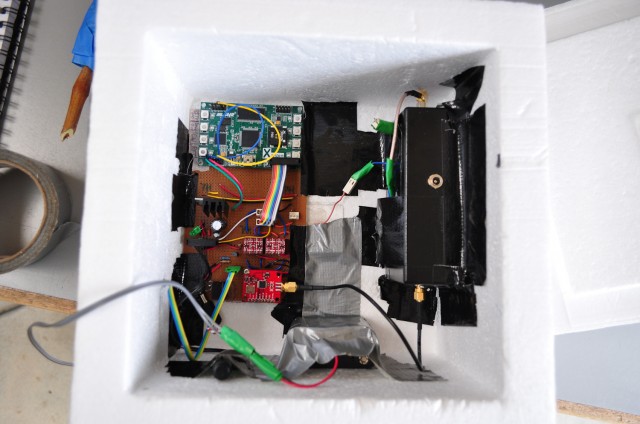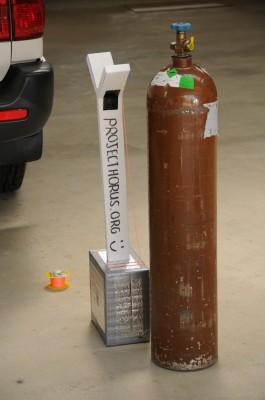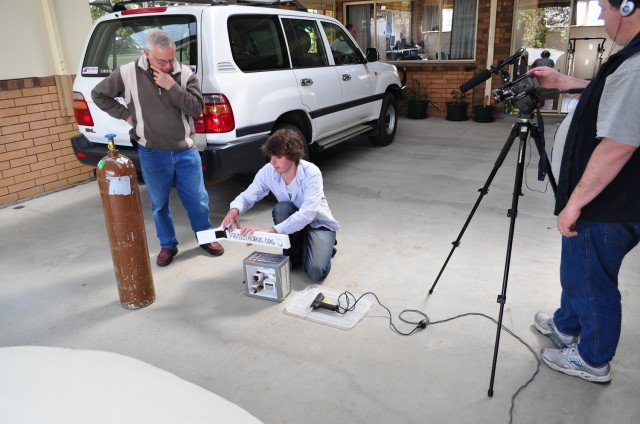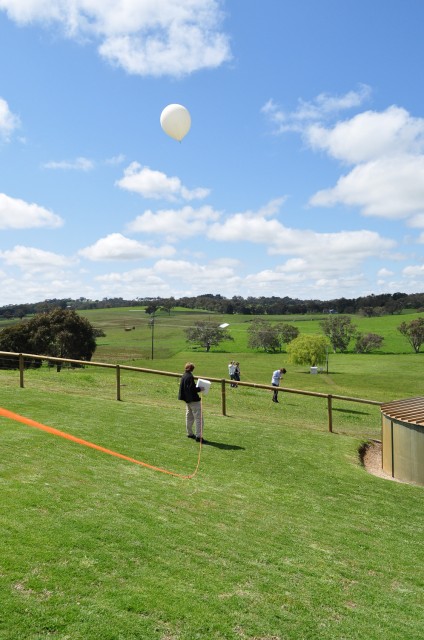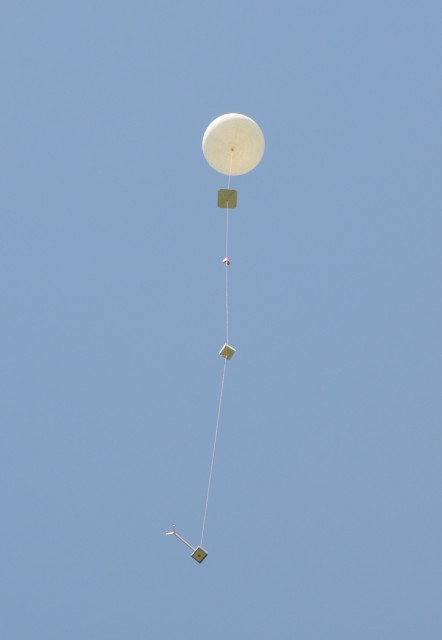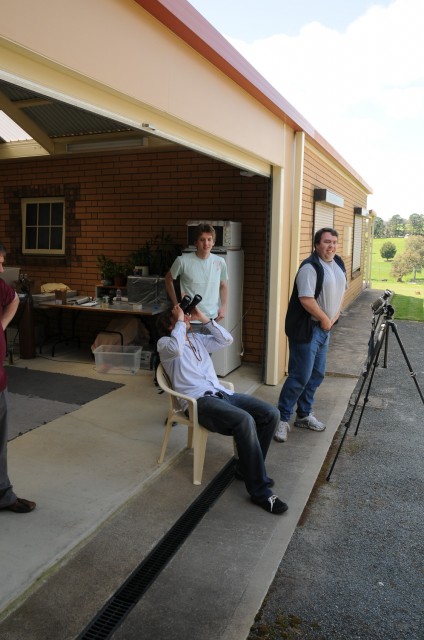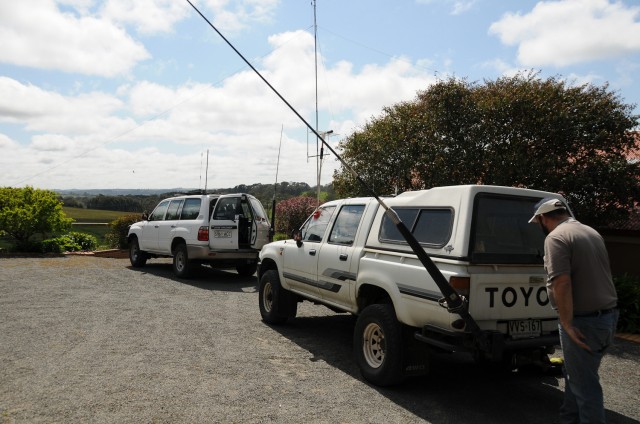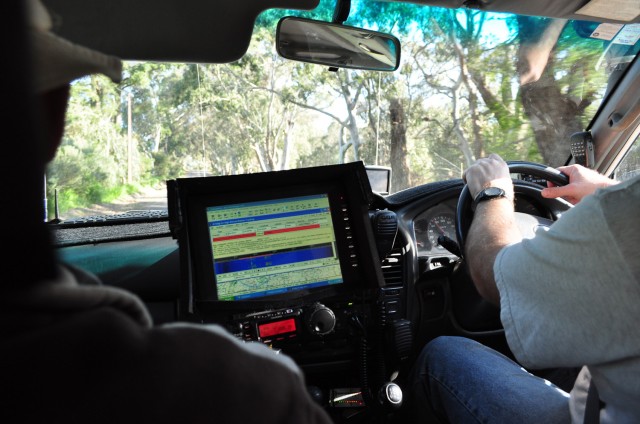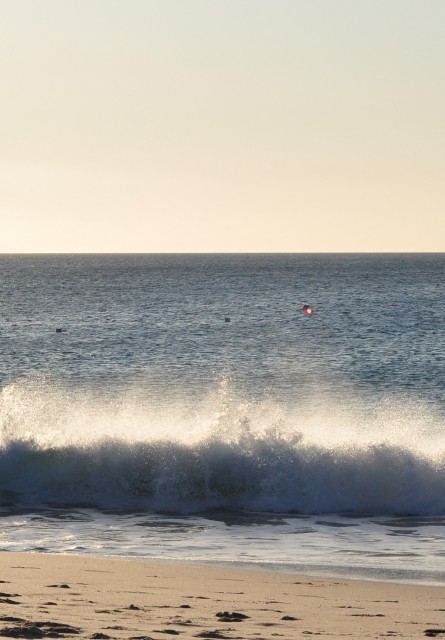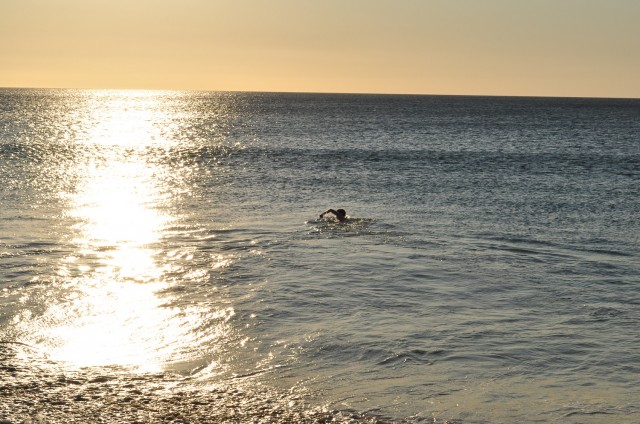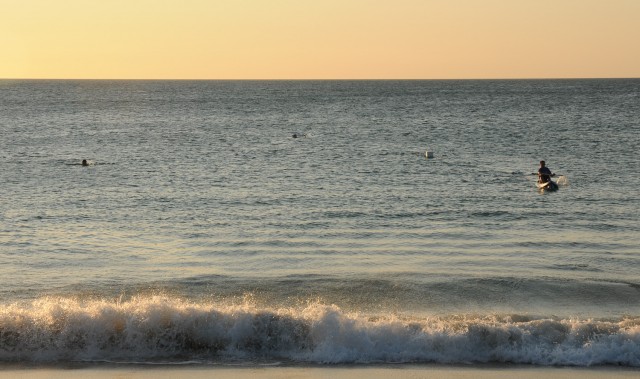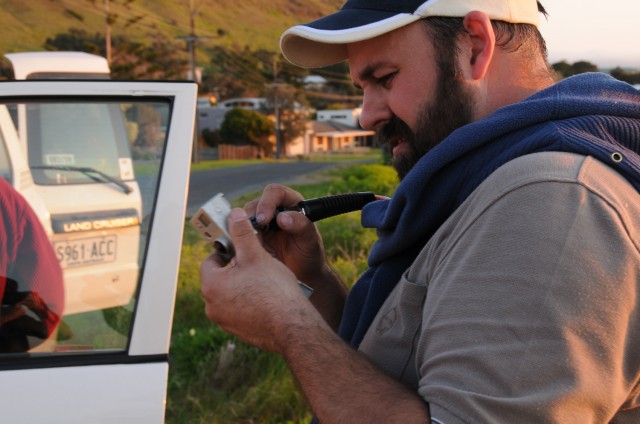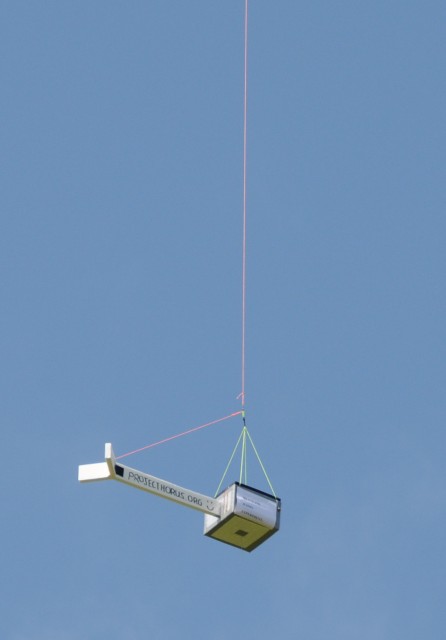Horus 8
Technical information:
| Launch date | 9/10/2010, 12:30pm |
| Landing date | 9/10/2010, 7:00pm |
| Flight duration | ~ 6.5 hours |
| Launch site | -35.1018, 138.8248 |
| Landing site | -35.4148, 138.3231 |
| Flight path | Web, KMZ |
| Distance travelled |
57.3 km |
| Maximum altitude | 32,101 m |
| Average ascent rate | 1.5m/s |
| Impact speed | 6 m/s (22 km/h) |
| Flight computer | Nut 1.1 flight computer, HF telemetry experiment |
| GPS module | Falcom FSA03 |
| Radio transmitter | Radiometrix NTX2 25mw |
| Video Camera | GoPro HD Hero 1080p |
| Telemetry | 300 baud RTTY, CRC16 checksum on UHF & HF |
| Tracking | Ground stations (distributed listener), 3 chase cars, web based tracker |
Details:
Horus 8 was a test of a HF telemetry system being developed by a friend of ours - Electrical Engineering student & high altitude balloon enthusiast Mark, as well as the first trial flight of a GoPro HD Hero high definition video camera. It was also planned to fly Adrian's simplex repeater again, though this had to be cut from the payload at the last minute due to launch preparation issues.
Mark's HF telemetry system was built around an Atmel XMega & signal generator, as well as an amp he'd built. It was putting out approx 40mW of power on 7.037MHz, transmitting 300b RTTY, including GPS location, temperature & battery voltages. The goal of the flight was to test the performance of the system in both harsh conditions & over a long range.
This launch was also a precursor to a launch we'd planned the next day (10/10/10) for the One Day on Earth movement - we were trialling HD video using a GoPro HD Hero. It was hoped that the same payload (minus the HF experiment) would be flown the next day to capture footage for One Day on Earth.
As part of the video launch we were also experimenting with a trailing fin design - intended to keep the payload pointed in one direction in the wind, to avoid the usual spinning - this seemed to work well!
Launch:
Launch conditions on the day were great - clear skies, minimal wind at ground level and being the beginning of spring, pleasantly warm. Graham VK5GH had also offered us the use of his garage for setup & inflation, which was a great help with this more complex payload.
Grant VK5GR was also recording video footage of the whole day, which we'll no doubt see online soon!
Launch preparations went smoothly for the most part, until we attempted to tie the balloon off - unfortunatley it slipped out of out gloved hands, and before we could catch it, it was bobbing around the ceiling, with it's open neck quickly pouring out helium! ![]() Fortunately thanks to some quick thinking of behalf of Graham, we managed to retrieve the balloon with a ladder before too much gas was lost, and continue filling. The loss of gas meant that we needed to reduce our payload mass, so the repeater was pulled from the flight (little did we know this would end up to be a fortunate removal!).
Fortunately thanks to some quick thinking of behalf of Graham, we managed to retrieve the balloon with a ladder before too much gas was lost, and continue filling. The loss of gas meant that we needed to reduce our payload mass, so the repeater was pulled from the flight (little did we know this would end up to be a fortunate removal!).
The balloon train for this launch was the longest yet - the HF antenna for Mark's payload spanned 10m both above and below it - with the rest of the gear (radar reflector, parachute, etc), we were looking at a very long balloon train!
Our intended ascent rate for this launch was 3m/s - fortunately weather conditions for the day were ideal, with predictions suggesting the balloon would drift some distance away & then return to almost exactly the launch site, regardless of the ascent rate.
A few minutes before launch our payloads were assembled & ready to go, with one exception - my UHF telemetry system had not acquired GPS lock, despite having had a good deal of time to do so. After ~20 minutes of waiting, the payload started broadcasting valid coordinates, so we sealed everything up and launched.
Flight:
No sooner than we'd launched we realised we had a couple of issues: our asc rate was far too slow (~1m/s), and the primary telemetry system (UHF) had lost lock. With Mark's system having never been tested over a long range or at altitude, the thought of relying on an untested system was a bit worrying - thankfully it seemed to be performing perfectly!
The ascent rate posed another issue - with the payload only rising at 1m/s, it would be many hours before we reached apogee, which meant the payload would land after dark. Fortunately predictions suggested the landing site would not be moved too far, so we hoped that recovery would still be relatively easy.
About 20 minutes after launch, my telemetry system finally got lock - and held it for the remainder of the flight. Fortunately for us, the ascent rate increased to 1.5-2m/s as the gas inside the balloon warmed as it rose above the clouds - meaning that it looked like the payload would before dark after all - though it would still be a very long flight. The obvious fix for this was to settle down and have a great BBQ & beer courtesy of Matt, Grant and Scott (thanks guys! ![]() ).
).
Grant VK5GR did a great job of editing the footage from the onboard camera, and put together this excellent video - thanks Grant!
Recovery:
4-5 hours after launch, the balloon had reached ~30km, had turned around & was heading back towards the launch site at 100km/h. We packed up the cars and set out to the predicted landing site (near Meadows, only a few km away), splitting up and taking different roads along the way.
We soon noticed something rather alarming - rather than bursting, the balloon had reached a state of float at ~32km altitude. It wasn't ascending or descending, but it was still moving along at 100km/h! We frantically tried to stay ahead of it & get into position to intercept it when it did burst, but this did not prove easy. The balloon shot past the expected landing site and kept on going - heading straight out to sea. For the next hour, our chase cars raced towards the coast, all the while hoping the balloon would burst
Before long, the balloon was above the sea, and our hopes shifted to it bursting and our payload landing on Kangaroo Island - this would have made recovery almost impossible (access is by ferry crossing only), but it was always possible that someone could find the payload & return it to us via the contact details listed on the payload. However, at the last possible second, the balloon burst! We knew that a lower altitude wind inversion meant it was still possible our payload could end up on land, but it was too close to call - looking back now, if the balloon had burst even a few seconds later (it was heading out to sea at 100km/h), recovery would have been entirely impossible without a boat.
Our 3 chase teams were now scrambling to get to the expected landing site (Carrickalinga, a tiny beachside holiday town) - we all arrived within a few moments of one another, with Adrian & Matt's chase teams arriving in time to watch the payload come down - into the sea!
The payload landed only 50m or so out to sea - but the open parachute caught the wind and started dragging it out to sea. By the time I'd arrived (only 1-2 minutes later), it was far enough out that it was very hard to spot, though the GPS tracking was still working! There was some scrambling to try to get a kayak spotted down the beach ready to recover the payload, but I decided to go for it before the payload ended up too far out and lost forever.
After a few failed attempts at getting the kayak going (as it turns out Maxtrax do not make good paddles!), Joel managed to get hold of an actual paddle from a local & came out to help me bring the payload back in - the current and wind heading out to sea was making pulling the balloon train (complete with parachute) back to shore very hard going.
Results/post-mortem:
Once back on dry land, I went off to seek a shower before I froze to death in the wind - thanks to all the locals who helped out, especially for letting a stranger invade their bathroom for a hot shower! ![]()
The rest of the chase teams started pulling apart the payloads and irrigating all the electronics to displace as much sea water as possible - air compressors in 4WD's certainly helped in this regard! Mark's HF payload was quite well sealed and did not suffer a great deal of water ingress - though still enough to cause some corrosion. However, the main payload containing the video did not fare so well - the hole the lens stuck out of allowed water in, which also resulted in the payload being dragged under water on it's way back to shore. The flight computer was very corroded, to the extent that some tracks were entirely eaten away.
Back at Graham VK5GH's place, some final cleaning & re-assembly took place before testing to see what had failed...
| Item | Status |
| GoPro HD Hero video camera | Dead (unsurprisingly) |
| Video camera battery system | Dead |
| Video camera SD card | Working |
| Horus flight computer | Partially working |
| HF Telemetry system | Working |
| Adrian's MAXTRAX | Lost at sea |
| Adrian's glasses | Lost at sea |
Whilst the SD card for the GoPro HD Hero was functioning, it turns out only 42 minutes of footage were captured - we were expecting at least 4 hours. Initially this appeared to be because of the 4GB FAT32 filesize limit, but as it turns out the camera is supposed to be capable of starting a new file (continuing the recording) once it reaches this barrier. I'm still unsure as to why the recording ended early - I've opened a support case with GoPro and am waiting to hear back as to what might have stopped the camera from continuing its recording. However, the footage that was captured shows that the stabilising fin had a significant impact in reducing the spin of the payload. There's certainly still room for improvement, but with even this simple fin, the payload spun far less than previous flights.
Conclusion:
Whilst this launch was without a doubt the most challenging so far in terms of recovery & the only flight on which equipment has been lost/damaged, it was not without success. The HF telemetry experiment went very well, and was logged for the duration of the entire flight. The HF telemetry did prove more difficult to decode while mobile, but was rock solid when stationary.
Furthermore, our stabilising fin design proved to be quite successful, limiting the spin on the payload, and our chase teams gained a good deal of experience in tracking in difficult circumstances. The long flight time also presented an ideal opportunity for systems testing & setup - this was the first time Matt VK5ZM's tracking systems had been used with the Horus telemetry systems.
Unfortunately the length of the flight & the water damage sustained meant the payload could not be flown the following day for One Day on Earth - by the time we had recovered everything and were back at the launch site, it was quite late. However, weather predictions for the next day were not favourable, and it seemed likely that we might end up in the water if we launched that day too.
The failures of this launch essentially come down to under-inflation of the balloon - this caused both the low ascent rate and the float situation, very nearly resulting in the loss of the payload. We'll take these failings into account in future launches and somewhat re-think the gas/lift calculations used.
I'd like the give a big thanks to everybody who helped to make the day possible, especially to Grant VK5GR for funding the Helium and Graham VK5GH & Carol for letting us spend the entire day at their place (and looking after us!). An extra thanks to everybody who helped with tracking - the data relayed by stations via the internet is invaluable to us in the chase cars when surrounding conditions (trees/hills etc) make decoding a radio signal difficult.
With any luck the next launch will go a little more smoothly! ![]()
